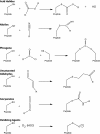Sensory detection and responses to toxic gases: mechanisms, health effects, and countermeasures
- PMID: 20601631
- PMCID: PMC3136963
- DOI: 10.1513/pats.201001-004SM
Sensory detection and responses to toxic gases: mechanisms, health effects, and countermeasures
Abstract
The inhalation of reactive gases and vapors can lead to severe damage of the airways and lung, compromising the function of the respiratory system. Exposures to oxidizing, electrophilic, acidic, or basic gases frequently occur in occupational and ambient environments. Corrosive gases and vapors such as chlorine, phosgene, and chloropicrin were used as warfare agents and in terrorist acts. Chemical airway exposures are detected by the olfactory, gustatory, and nociceptive sensory systems that initiate protective physiological and behavioral responses. This review focuses on the role of airway nociceptive sensory neurons in chemical sensing and discusses the recent discovery of neuronal receptors for reactive chemicals. Using physiological, imaging, and genetic approaches, Transient Receptor Potential (TRP) ion channels in sensory neurons were shown to respond to a wide range of noxious chemical stimuli, initiating pain, respiratory depression, cough, glandular secretions, and other protective responses. TRPA1, a TRP ion channel expressed in chemosensory C-fibers, is activated by almost all oxidizing and electrophilic chemicals, including chlorine, acrolein, tear gas agents, and methyl isocyanate, the highly noxious chemical released in the Bhopal disaster. Chemicals likely activate TRPA1 through covalent protein modification. Animal studies using TRPA1 antagonists or TRPA1-deficient mice confirmed the role of TRPA1 in chemically induced respiratory reflexes, pain, and inflammation in vivo. New research shows that sensory neurons are not merely passive sensors of chemical exposures. Sensory channels such as TRPA1 are essential for maintenance of airway inflammation in asthma and may contribute to the progression of airway injury following high-level chemical exposures.
Figures

Similar articles
-
Transient receptor potential A1 channels: insights into cough and airway inflammatory disease.Chest. 2011 Oct;140(4):1040-1047. doi: 10.1378/chest.10-3327. Chest. 2011. PMID: 21972382 Free PMC article.
-
Transient receptor potential ankyrin 1 antagonists block the noxious effects of toxic industrial isocyanates and tear gases.FASEB J. 2009 Apr;23(4):1102-14. doi: 10.1096/fj.08-117812. Epub 2008 Nov 26. FASEB J. 2009. PMID: 19036859 Free PMC article.
-
A sensory neuronal ion channel essential for airway inflammation and hyperreactivity in asthma.Proc Natl Acad Sci U S A. 2009 Jun 2;106(22):9099-104. doi: 10.1073/pnas.0900591106. Epub 2009 May 19. Proc Natl Acad Sci U S A. 2009. PMID: 19458046 Free PMC article.
-
Chloropicrin-induced toxicity in the respiratory system.Toxicol Lett. 2020 May 1;323:10-18. doi: 10.1016/j.toxlet.2020.01.022. Epub 2020 Jan 23. Toxicol Lett. 2020. PMID: 31982502 Review.
-
Chemosensory TRP channels in the respiratory tract: role in toxic lung injury and potential as "sweet spots" for targeted therapies.Rev Physiol Biochem Pharmacol. 2013;165:31-65. doi: 10.1007/112_2012_10. Rev Physiol Biochem Pharmacol. 2013. PMID: 23532495 Review.
Cited by
-
Menthol attenuates respiratory irritation and elevates blood cotinine in cigarette smoke exposed mice.PLoS One. 2015 Feb 13;10(2):e0117128. doi: 10.1371/journal.pone.0117128. eCollection 2015. PLoS One. 2015. PMID: 25679525 Free PMC article.
-
Effect of dibenz(b,f)-1,4-oxazepine aerosol on the breathing pattern and respiratory variables by continuous recording and analysis in unanaesthetised mice.Toxicol Rep. 2020 Sep 1;7:1121-1126. doi: 10.1016/j.toxrep.2020.08.022. eCollection 2020. Toxicol Rep. 2020. PMID: 32953463 Free PMC article.
-
Chlorine-induced cardiopulmonary injury.Ann N Y Acad Sci. 2016 Jun;1374(1):159-67. doi: 10.1111/nyas.13091. Epub 2016 Jun 15. Ann N Y Acad Sci. 2016. PMID: 27303906 Free PMC article. Review.
-
Association between oxidative balance score and self-reported severe headache or migraine based on NHANES 1999 to 2004 data: A cross-sectional study.Heliyon. 2024 Mar 8;10(6):e27426. doi: 10.1016/j.heliyon.2024.e27426. eCollection 2024 Mar 30. Heliyon. 2024. PMID: 38500974 Free PMC article.
-
An Official American Thoracic Society Workshop Report: Chemical Inhalational Disasters. Biology of Lung Injury, Development of Novel Therapeutics, and Medical Preparedness.Ann Am Thorac Soc. 2017 Jun;14(6):1060-1072. doi: 10.1513/AnnalsATS.201704-297WS. Ann Am Thorac Soc. 2017. PMID: 28418689 Free PMC article.
References
-
- Taylor-Clark T, Undem BJ. Transduction mechanisms in airway sensory nerves. J Appl Physiol 2006;101:950–959. - PubMed
-
- Brown JA. Information on hazardous chemicals and occupational diseases.2009.
-
- Guidotti TL. An international registry for toxic inhalation and pulmonary edema: notes from work in progress. Int Arch Occup Environ Health 1996;68:380–386. - PubMed
-
- Bianchi ME. DAMPs, PAMPs and alarmins: all we need to know about danger. J Leukoc Biol 2007;81:1–5. - PubMed
Publication types
MeSH terms
Substances
Grants and funding
LinkOut - more resources
Full Text Sources
Other Literature Sources
Molecular Biology Databases
